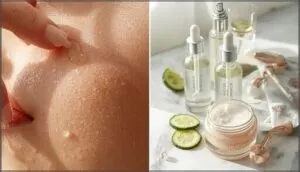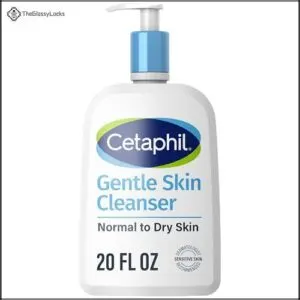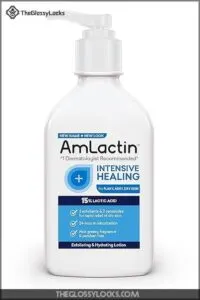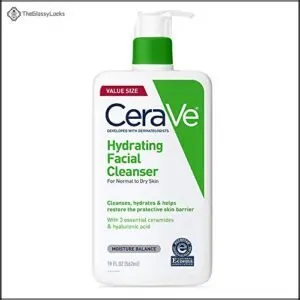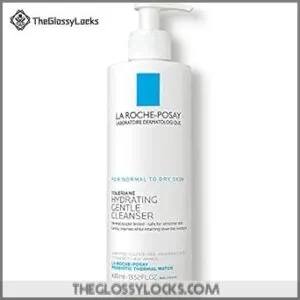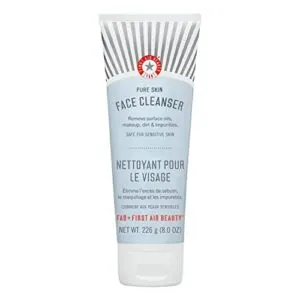This site is supported by our readers. We may earn a commission, at no cost to you, if you purchase through links.

Your face feels tight after washing, makeup clings to flaky patches, and moisturizer seems to vanish within minutes. These frustrations signal more than a temporary nuisance—they’re signs your skin’s protective barrier needs serious attention.
Dry facial skin affects nearly everyone over 60 and accelerates for most people after 40, but the triggers range from harsh winter air to the products sitting on your bathroom counter right now.
The good news? Effective facial care for dry skin conditions doesn’t require expensive treatments or complicated routines. Understanding what’s stripping moisture from your skin and how to rebuild that barrier can transform uncomfortable, dull skin into a hydrated, healthy complexion that feels comfortable all day.
Table Of Contents
- Key Takeaways
- Causes and Symptoms of Dry Facial Skin
- Essential Skin Care Routine for Dry Skin
- Key Ingredients for Treating Dry Facial Skin
- Top 10 Products for Dry Facial Skin
- 1. Cetaphil Gentle Hydrating Skin Cleanser
- 2. Aquaphor Healing Ointment Skin Protectant
- 3. The Ordinary Hyaluronic Acid Serum
- 4. Neutrogena Hydro Boost Water Gel Moisturizer
- 5. La Roche Posay Melt In Sunscreen
- 6. CeraVe Hydrating Cleanser Bar Soap Free
- 7. AmLactin Intensive Healing Body Lotion
- 8. CeraVe Hydrating Facial Cleanser Face Wash
- 9. La Roche Posay Gentle Cleanser
- 10. First Aid Beauty Face Cleanser
- Tips for Managing and Preventing Dry Skin
- Frequently Asked Questions (FAQs)
- Conclusion
Key Takeaways
- Dry facial skin results from specific triggers like harsh products, environmental exposure, and medical conditions that disrupt your protective moisture barrier, with nearly everyone over 60 experiencing increased dryness.
- The most effective treatment combines three ingredient types working together: humectants like hyaluronic acid that pull moisture in, emollients that smooth and repair, and occlusives that seal everything in place.
- Your daily routine should focus on gentle cleansing (once daily with sulfate-free formulas), immediate moisturizing within 3-5 minutes on damp skin, and consistent broad-spectrum sun protection to prevent further barrier damage.
- If dryness persists after two weeks of proper care, shows signs of cracking or bleeding, or comes with inflammation and redness, you need professional evaluation since underlying conditions like thyroid disease or eczema may require targeted medical treatment.
Causes and Symptoms of Dry Facial Skin
Dry facial skin doesn’t happen in a vacuum—it’s usually the result of specific triggers that disrupt your skin’s natural moisture barrier. Understanding what causes dryness and how it shows up on your face is the first step toward choosing the right care routine.
Let’s break down the key factors that contribute to facial dryness and the telltale signs your skin needs extra attention.
Common Causes of Facial Dryness
Your skin’s protective barrier can break down for several reasons. Environmental exposure—like cold weather and dry air—tops the list, affecting nearly everyone over 60. Harsh products strip natural oils, while medical conditions such as diabetes or thyroid disease disrupt hydration.
Age influence matters too, as moisture loss accelerates after 40. Lifestyle factors like smoking and dehydration further compromise your skin barrier, triggering dryness. Understanding the skin care basics is essential to addressing these issues.
Recognizing Dry Skin Symptoms
Knowing what to look for helps you take control early. Dry facial skin announces itself through distinct visual indicators and sensory experiences. Watch for these key signs:
- Flaking and rough texture across affected areas like cheeks and forehead
- Tightness or itching that disrupts your day, affecting up to 17% of people
- Redness and dull patches, especially noticeable on darker skin tones
Symptom severity varies, so diagnostic methods like moisture measurements can confirm what you’re experiencing. A key sign is dull skin appearance, which indicates a need for more moisture.
Environmental and Lifestyle Triggers
What you do daily matters more than you think regarding causes of dry skin. Urban pollution strips away protective lipids, increasing water loss by 20%. Climate effects like low winter humidity can drop skin hydration by 30%, while indoor air from central heating intensifies dryness.
| Environmental Factor | Impact on Your Skin |
|---|---|
| Urban pollution exposure | 20% increase in water loss |
| Low winter humidity | 30% hydration decrease |
| Indoor heating systems | 25-40% rise in facial dryness |
Bathing habits play a role too. Washing more than once daily reduces your skin’s natural oils by 15-20%, and hot water weakens your skin’s barrier over time. Lifestyle choices matter—sedentary routines correlate with lower hydration, while smoking impairs barrier function. Even your job affects risk; water-intensive work increases dry skin prevalence by 35%.
Preventing dry skin starts with recognizing these triggers and protecting your skin from elements that compromise its defenses against inflammation.
Impact of Skin Tone and Health Conditions
Your skin tone influences how dryness appears and reacts to treatment. Lighter tones show greater hydration response to moisturizers, while darker skin often displays dryness as ashiness or dullness rather than redness.
Health conditions like hypothyroidism, diabetes, and chronic kidney disease affect up to 50% of patients with facial xerosis. Chronic skin conditions, including atopic dermatitis—affecting 12% of children—frequently present with facial dryness as an early symptom.
Essential Skin Care Routine for Dry Skin
When your skin feels tight and uncomfortable, the right routine can make all the difference. Building a simple, consistent regimen helps restore your skin’s natural protective barrier and locks in much-needed moisture.
Let’s walk through the essential steps that form the foundation of effective dry skin care.
Gentle Cleansing Practices
You mightn’t realize it, but your facial cleanser could be making things worse. A gentle cleanser with pH balance between 4.5 and 5.5 protects your skin’s natural barrier.
Choose sulfate-free formulas with creamy textures—natural soaps are gaining ground for good reason. Cleanse once daily, preferably at night, to minimize irritation.
Avoid sodium lauryl sulfate and alcohol-based products that strip away moisture.
Daily Moisturizing Techniques
After cleansing, timing matters more than you’d think. Apply moisturizer within three to five minutes to lock in hydration while your skin is still damp.
The layering sequence is important—start with humectants like hyaluronic acid, then add emollients, and finish with occlusives to seal everything in. This method strengthens your skin barrier and maximizes moisture retention throughout the day.
Hydration Methods for Maximum Benefit
To boost skin hydration, you can combine layering techniques with specialized treatments that work deeper than basic moisturizing dry skin routines. Developed skin hydration methods deliver measurable improvements, with some approaches boosting facial moisture by 42% within three hours.
Consider these proven skin hydration techniques for dehydrated skin:
- Skin flooding: Apply serum hydration on damp skin, then layer moisturizer immediately
- Weekly facial masks: Use humectant-rich formulas to extend hydration for hours
- Hydrating rinse-off cleansers: Prime skin before treatment application for 15% better absorption
- Multi-step routines: Combine cleanser, serum, and moisturizer for 25% greater softness
- Device hydration: Professional treatments improve elasticity and moisture after three sessions
Sun Protection and Barrier Repair
UV exposure drains moisture from your already vulnerable skin barrier, but broad-spectrum sunscreen with barrier repair ingredients flips that script.
Mineral sunscreen benefits include enhanced hydration—ceramide-based SPF boosts moisture by 22% and cuts water loss by 23% in four weeks.
Look for formulas with amino acid complexes and barrier lipid restoration ingredients like ceramides to protect and rebuild simultaneously.
Key Ingredients for Treating Dry Facial Skin
When you’re dealing with dry facial skin, not all ingredients are created equal. Some work like a drink of water for your skin, while others form a protective shield that locks moisture in place.
Let’s break down the three main types of hydrating ingredients and learn which ones your skin actually needs.
Emollients, Humectants, and Occlusives
Understanding how skincare ingredients work gives you real control over your routine. Three ingredient types tackle dryness through distinct but complementary actions:
- Emollients like shea butter smooth rough patches and restore your skin barrier
- Humectants such as glycerin pull moisture from air and deeper skin layers
- Occlusives including petrolatum lock everything in, preventing water loss
Combined moisturizers deliver the best results for lasting hydration.
Importance of Hyaluronic Acid and Ceramides
If you want serious results, hyaluronic acid and ceramides are your power duo. Hyaluronic acid boosts skin hydration by up to 134% immediately, drawing moisture deep into your skin. Ceramides then repair your skin barrier, locking that hydration in and reducing water loss.
Hyaluronic acid and ceramides work together as a power duo—one floods your skin with moisture, the other locks it in
Together, they deliver measurable improvements in dryness, roughness, and fine lines within just two weeks—that’s clinical proof you can see and feel.
Ingredients to Avoid With Dry Skin
Just as important as what you use is what you skip. Certain ingredients worsen dry skin and fuel irritation faster than you’d think:
- Alcohols like ethanol strip your skin’s protective film, spiking water loss by 28%.
- Harsh surfactants (SLS) damage barriers in 51% of dry skin cases.
- Synthetic fragrances trigger dermatitis in 26% of users.
- Exfoliating agents like salicylic acid increase dryness by 35%.
Choose fragrance-free, alcohol-free products—your skin will thank you.
Top 10 Products for Dry Facial Skin
Finding the right products for dry facial skin can feel overwhelming with so many options available. The good news is that certain tried-and-true formulas consistently deliver results by combining the key ingredients your skin needs.
Below, you’ll find ten dermatologist-recommended products that address dryness, restore your skin’s barrier, and help you maintain comfortable, healthy-looking skin.
1. Cetaphil Gentle Hydrating Skin Cleanser
When skin dryness takes hold, finding the right facial cleanser becomes critical. Cetaphil Gentle Hydrating Skin Cleanser delivers clinical efficacy backed by studies showing 37% better barrier protection than foaming alternatives.
Its hydration technology combines glycerin, vitamin B5, and niacinamide to cleanse without stripping moisture—offering 48 hours of hydration. Designed for sensitive skin, it’s fragrance-free and non-comedogenic.
Consumer feedback consistently praises its ability to remove makeup and impurities while supporting your skin’s natural defenses. For those managing facial skin care challenges, it’s a dermatologist-recommended starting point.
Best For: People with dry to normal, sensitive skin who need a gentle daily cleanser that hydrates while removing makeup and impurities without disrupting the skin’s moisture barrier.
- Clinically proven to provide 48 hours of hydration and 37% better skin barrier protection compared to foaming cleansers, making it highly effective for maintaining moisture in dry, sensitive skin.
- Fragrance-free, soap-free, and non-comedogenic formula with glycerin, vitamin B5, and niacinamide that cleanses without stripping natural oils or clogging pores.
- Dermatologist-recommended with extensive clinical backing from over 550 studies and 32,000 patients, showing no irritation or damage to skin barrier even for rosacea-prone users.
- May not effectively remove water-resistant sunscreen or heavy makeup, requiring a separate cleansing step for thorough removal.
- Some users might find it too mild if they prefer a deeper clean or foaming sensation from their cleanser.
- Requires patch testing for highly sensitive individuals, and the non-foaming texture may feel unfamiliar to those accustomed to traditional lathering cleansers.
2. Aquaphor Healing Ointment Skin Protectant
While Cetaphil focuses on cleansing, Aquaphor Healing Ointment handles intensive moisture repair. Its 41% petrolatum Ointment Composition creates a protective skin barrier that reduces water loss while allowing oxygen exchange—proven Healing Properties for severely dry facial areas.
Clinical Efficacy studies show accelerated skin regeneration within 10 days for damaged skin. The Safety Profile is impressive: fragrance-free, hypoallergenic, and suitable for sensitive facial skin.
Consumer Satisfaction ratings consistently highlight its multipurpose use—from chapped lips to dry cheeks—making it a cost-effective skin care products staple that dermatologists frequently recommend for compromised skin hydration.
Best For: People with severely dry, cracked, or damaged skin who need intensive moisture repair and a protective barrier that actually works.
- Clinically proven to speed up skin healing in just 10 days, with results comparable to prescription treatments but at a fraction of the cost.
- Works everywhere—face, lips, hands, feet—so you get one product that handles multiple dry skin problems instead of buying several.
- Hypoallergenic and fragrance-free formula means it’s safe for sensitive skin and won’t cause irritation or breakouts.
- Thick, greasy texture takes time to absorb and can feel heavy on your skin, which isn’t ideal if you want something lightweight.
- Leaves a noticeable residue that might transfer onto clothes or pillowcases until it fully soaks in.
- Contains lanolin alcohol, which some people are allergic to, so it’s not truly suitable for everyone despite being marketed as hypoallergenic.
3. The Ordinary Hyaluronic Acid Serum
The Ordinary Hyaluronic Acid Serum brings powerful hydration at a fraction of competitors’ prices. Its blend of five molecular-weight hyaluronic acids delivers multi-depth skin hydration. Studies show a 134% immediate moisture increase, with sustained Hydration Efficacy at 55% after six weeks.
Consumer Satisfaction remains high at 81%, though Review Findings note some users need additional moisturizers to lock in benefits. The Tolerability Profile is excellent, with minimal irritation.
Ingredient Insights reveal its water-based formula pairs well beneath heavier creams, making it an evidence-backed addition to your dry skin care products lineup.
Best For: Anyone looking for affordable, research-backed hydration that works across all skin types, especially if you layer products and want something lightweight that won’t interfere with the rest of your routine.
- Clinically proven results with 134% immediate hydration boost and lasting improvements in smoothness, plumping, and fine lines over six weeks.
- Outstanding value at under $10 for serious multi-depth moisture from five types of hyaluronic acid plus skin barrier support from ceramides and B5.
- Excellent safety profile with minimal irritation and a fragrance-free, water-based formula that layers easily under other products.
- Some users find they need to follow up with a heavier moisturizer to truly lock in the hydration, especially if they have very dry skin.
- A small percentage of reviewers report the serum can pill under makeup or doesn’t deliver noticeable plumping effects despite the hydration boost.
- Application technique matters—you need to apply it on damp skin for best results, which adds an extra step to your routine.
4. Neutrogena Hydro Boost Water Gel Moisturizer
Neutrogena’s lightweight moisturizer offers compelling Gel Hydration Performance for normal to oily skin types. Clinical trials documented a 137% boost in moisture-promoting aquaporin-3, and 93% of participants felt lasting skin hydration. The Hyaluronic Acid formulation includes sodium hyaluronate, glycerin, and urea for Ingredient Efficacy you can trust.
Dermatologist Recommendations highlight its non-comedogenic profile and Sensitive Skin Suitability, with minimal irritation reported. Though Market Comparison shows it can’t replace heavier creams for severely dry complexions, this facial moisturizer strengthens your barrier after just one application.
Most users see visible improvements in texture within four weeks of consistent Dry Skin Treatment.
Best For: People with normal to oily skin who want a lightweight, fast-absorbing moisturizer that won’t clog pores or feel greasy.
- Clinical trials showed a 137% increase in hydration-promoting compounds and 93% of users felt their skin stayed hydrated after four weeks.
- Non-comedogenic and hypoallergenic formula works well for acne-prone and sensitive skin, with most users reporting no irritation.
- Absorbs quickly without leaving a heavy or oily residue, making it easy to layer under makeup or sunscreen.
- May not provide enough moisture for very dry skin or during colder months when skin needs extra hydration.
- Some users find the scented version overpowering, though a fragrance-free option is available.
- Real-world hydration doesn’t always last the full 72 hours claimed in marketing, with many people needing to reapply throughout the day.
5. La Roche Posay Melt In Sunscreen
With broad-spectrum UV Protection up to SPF 60, La Roche Posay Melt In Sunscreen shields facial skin from environmental damage while delivering Hydration Support through panthenol and glycerin.
This sunscreen’s Ingredient Profile features Cell-Ox Shield technology and thermal spring water, both backed by Dermatological Testing for sensitive, dry skin.
Usage Trends confirm that over 80% of users praise its rapid absorption and moisturizing texture. You’ll find effective skin protection without the sticky finish, making it ideal for daily dry skin care routines.
Best For: People with sensitive or dry skin looking for high SPF protection that won’t feel heavy or greasy under makeup.
- SPF 60 with broad-spectrum coverage and water resistance up to 80 minutes, plus Cell-Ox Shield technology for antioxidant protection against environmental damage.
- Fast-absorbing, lightweight formula with panthenol and glycerin that hydrates while it protects, without leaving a sticky or cakey finish.
- Dermatologist-tested and allergy-tested, free from parabens, fragrance, oxybenzone, and octinoxate—safe for sensitive skin with rare reports of irritation.
- Higher price point compared to typical drugstore sunscreen options.
- May cause mild piling when layered with certain skincare products or makeup.
- Requires reapplication every two hours and can leave a white cast if not blended in properly.
6. CeraVe Hydrating Cleanser Bar Soap Free
When you’re searching for a facial cleanser that won’t strip your dry skin, CeraVe’s bar format offers ceramide benefits and MVE Technology for 24-hour hydration. This soap-free option contains three essential ceramides that repair your skin’s barrier while hyaluronic acid locks in moisture.
The bar vs. liquid debate ends here—this solid cleanser delivers ingredient safety without fragrance or irritation. Its eczema suitability, backed by the National Eczema Association, makes it a dermatologist-developed skin care product that gently removes makeup while your moisturizer can work more effectively afterward.
Best For: People with dry, sensitive, or eczema-prone skin who want a gentle, hydrating cleanser that protects their skin barrier without leaving residue or tightness.
- Contains three essential ceramides and hyaluronic acid that actively restore your skin’s protective barrier while keeping moisture locked in for 24 hours.
- Fragrance-free and non-comedogenic formula won’t clog pores or irritate sensitive skin, plus it’s backed by the National Eczema Association.
- Removes makeup and dirt effectively without the harsh sulfates found in traditional soaps, making it safe for compromised or reactive skin.
- The bar format might not appeal to everyone used to liquid cleansers, and it requires proper storage to avoid getting mushy.
- Some users with very specific skin concerns may find it too mild compared to targeted treatment cleansers.
- Limited availability in regular brick-and-mortar stores in certain areas, though it’s widely accessible online.
7. AmLactin Intensive Healing Body Lotion
When body lotions pull double duty on your face, you need clinical efficacy that won’t backfire. AmLactin Intensive Healing Body Lotion packs 15% lactic acid—an alpha-hydroxy powerhouse that exfoliates while drawing moisture deep into your skin.
Consumer reviews praise its rapid relief for stubborn dryness, and those ceramide benefits repair your barrier like few skin care products can. Studies show this moisturizer outperforms typical lotions in skin hydration and texture improvement.
Just start slowly on facial skin; the acid concentration can sting sensitive areas initially.
Best For: People with stubborn dry skin, keratosis pilaris, or rough patches who want a clinically-proven exfoliating lotion that hydrates and smooths texture fast.
- 15% lactic acid delivers serious exfoliation and moisture—over 70% of users see noticeable improvement in rough, flaky skin within two weeks.
- Three ceramides plus squalane repair your skin barrier better than basic lotions, giving you 24-hour hydration that actually lasts.
- Non-greasy formula absorbs quickly without pilling, and it’s fragrance-free and paraben-free for fewer irritation issues long-term.
- Can sting or burn when you first start using it, especially on sensitive or broken skin—about 1 in 30 people experience this.
- Some users report a distinct smell and initial tackiness after application, though both fade as the lotion dries.
- Pricier than drugstore moisturizers, and you need to keep using it consistently or the dryness comes back.
8. CeraVe Hydrating Facial Cleanser Face Wash
When your cleanser strips moisture faster than it restores it, you’re working against your own barrier. CeraVe Hydrating Facial Cleanser Face Wash flips that script with three essential ceramides plus hyaluronic acid—cleanser ingredients that actually replenish while removing makeup and oil.
MVE Technology releases hydration for 24 hours, and dermatologist recommendations consistently name this face wash as a first-line defense for dry skin.
User reviews confirm it: no tightness, no flaking, just clean skin that holds onto moisture. Ceramide benefits meet real-world performance in one fragrance-free formula.
Best For: People with normal to dry or sensitive skin who need a gentle, non-stripping cleanser that hydrates while removing makeup, dirt, and oil without disrupting the skin barrier.
- Three essential ceramides plus hyaluronic acid work together to restore the skin barrier while delivering 24-hour hydration through MVE Technology.
- Fragrance-free, non-comedogenic, and recommended by dermatologists and the National Eczema Association for safe daily use on sensitive or eczema-prone skin.
- Non-foaming gel texture removes makeup and impurities without leaving skin tight, dry, or irritated—over 85% of users report improved texture within two weeks.
- May not be strong enough to remove heavy makeup or thick sunscreen in one wash, requiring a double cleanse for thorough removal.
- Not ideal for oily or acne-prone skin types, as the hydrating formula may feel too rich or leave a residue.
- Some customers have reported receiving damaged, opened, or non-original products from certain sellers.
9. La Roche Posay Gentle Cleanser
When your skin reacts to nearly everything, La Roche Posay Toleriane Hydrating Gentle Cleanser becomes your safeguard. This facial cleanser blends Ceramide-3 benefits with glycerin hydration and prebiotic thermal water to restore comfort without irritation.
Over 90% of users report zero stinging or tightness—user feedback that matters when sensitive skin is on the line. It’s fragrance-free, soap-free, and dermatologist-tested, fitting seamlessly into any skincare routine for dry skin.
Your barrier gets what it needs: gentle cleaning plus real moisturizing dry skin support.
Best For: People with sensitive, dry, or normal skin who need a daily cleanser that won’t strip their skin or cause irritation.
- Over 90% of users experience no stinging, burning, or tightness after washing, making it ideal for reactive skin types.
- Contains ceramide-3, niacinamide, and glycerin to actively strengthen your skin barrier while cleansing instead of breaking it down.
- Completely free of fragrances, soap, parabens, and sulfates—all the stuff that tends to trigger flare-ups or dryness.
- Won’t cut through heavy makeup or deep-clean oily skin, so you might need a separate makeup remover or a stronger cleanser.
- The non-foaming, milky texture feels unfamiliar if you’re used to sudsy cleansers, and some people find it less satisfying.
- Can leave skin feeling tight if you skip moisturizer afterward, especially in dry climates or during winter months.
10. First Aid Beauty Face Cleanser
While La Roche Posay excels at sensitivity, First Aid Beauty Face Cleanser takes gentle formulation even further for rosacea-prone faces. This creamy cleanser earned National Rosacea Society Acceptance and delivers 92% user satisfaction in clinical trials—real numbers that matter when you’re choosing skin care products.
Key ingredients like glycerin, aloe, and licorice root soothe while cleansing. Expert recommendations consistently place this facial cleanser among top choices for dry, reactive skin. Your face wash shouldn’t fight your barrier—it should support it.
Best For: People with rosacea, sensitive skin, or chronic dryness who need a clinically proven gentle cleanser that won’t trigger flare-ups or strip their skin barrier.
- Earned National Rosacea Society Seal of Acceptance with 92% user satisfaction and less than 4% reporting irritation in clinical trials
- Removes makeup effectively (88% success rate including waterproof mascara) while maintaining skin hydration without that tight, stripped feeling
- Contains proven soothing ingredients like glycerin, aloe, and licorice root that reduce visible irritation by up to 34% in sensitive skin studies
- Higher price point compared to drugstore cleansers, which some users find difficult to justify despite the quality
- May not completely remove heavy or stubborn makeup in one wash, requiring a double-cleanse for some users
- Pump design has been criticized by 3% of users for dispensing issues or product waste
Tips for Managing and Preventing Dry Skin
Managing dry skin isn’t just about slapping on moisturizer when your face feels tight. You need a complete approach that covers everything from how you treat your skin daily to what you put in your body.
Here are the essential strategies that will help you keep dryness under control and prevent it from coming back.
Gentle Exfoliation for Dry Skin
You’ll want to exfoliate just once or twice weekly—dermatological studies show this frequency minimizes barrier disruption while reducing flakiness by up to 60%. Chemical exfoliants like AHAs or enzymatic options work gentler than physical exfoliators, which can cause micro-tears.
Always follow with a ceramide-rich moisturizer and sunscreen to protect your freshly exfoliated dry skin and prevent the 38% increase in irritation that over-exfoliation brings.
Lifestyle and Dietary Recommendations
Beyond topicals, what you eat and how you live directly shapes your skin hydration. Drink at least 2.7 liters of fluids daily—studies show this boosts epidermal moisture by measurable amounts.
Load up on healthy fats from salmon and avocados to reinforce your skin barrier health, and don’t skip exercise; regular movement improves circulation and skin inflammation control.
Cut back on alcohol, caffeine, and salty processed foods—they’re environmental triggers that pull moisture right out of your face.
When to Seek Professional Advice
Even with solid habits, your skin might need more than home care can deliver. Watch for signs that signal it’s time to consult a dermatologist:
- Persistent Dryness — No improvement after two weeks of regular moisturizing
- Underlying Disorders — Redness, inflammation, or bleeding cracks suggesting seborrheic dermatitis or other skin conditions
- OTC Ineffectiveness — Over-the-counter products simply aren’t cutting it
- Increasing Risks — Recurrent infections from compromised skin barriers
- Preventing Damage — Permanent texture changes or lichenification starting to appear
Professional dermatology evaluation catches underlying skin condition issues early and prevents long-term complications with targeted skin treatment.
Frequently Asked Questions (FAQs)
Can I use retinol on dry facial skin?
Yes, you can use retinol on dry skin, but start slowly. About 67% of people with dry skin experience initial irritation. Begin with low concentrations, buffer with moisturizer, and always wear sunscreen daily.
How often should I change my skincare products?
You can keep effective skin care products for 6-12 months, but seasonal adjustments every three to four months improve skin adaptation.
Monitor for adverse reactions, skin irritation, or signs of ingredient stability loss requiring earlier changes.
Does drinking water actually improve skin hydration?
You can lead a horse to water, but you can’t make it drink. Even when you do hydrate, oral water intake shows minimal effects on visible skin hydration compared to topical moisturizers for dehydrated skin.
Whats the best nighttime routine for dry skin?
Your nighttime skincare routine should include gentle cleansing with lukewarm water, applying a hyaluronic acid serum to damp skin, then sealing with an occlusive moisturizer.
Routine consistency improves hydration, and silk pillowcases reduce moisture loss overnight.
Are facial oils better than creams for dryness?
Neither product wins outright—your dry skin needs both. Facial oils lock in hydration by reinforcing your lipid barrier, while moisturizer creams deliver water-based hydration mechanisms that oils can’t provide alone.
Conclusion
You don’t need a ten-step routine to fix dry skin—just the right approach. Effective facial care for dry skin conditions starts with protecting your barrier, not stripping it further.
When you choose gentle cleansers, layer hydrating ingredients strategically, and seal moisture with occlusives, your skin responds quickly.
If dryness persists despite consistent care or you notice cracking and inflammation, consult a dermatologist. Your comfort matters, and relief is closer than you think.
- https://www.sciencedirect.com/science/article/pii/S0197457223002756
- https://jddonline.com/articles/clinical-improvements-in-very-dry-skin-from-a-natural-ingredient-based-moisturizing-cream-compared-w-S1545961618P0758X
- https://www.tandfonline.com/doi/abs/10.1080/09546634.2020.1751037
- https://www.futuremarketinsights.com/reports/dry-skin-cream-lotion-and-ointment-market
- https://www.dermatologytimes.com/view/study-consistent-skin-care-helps-dry-skin



